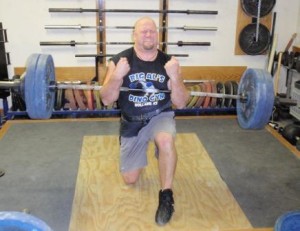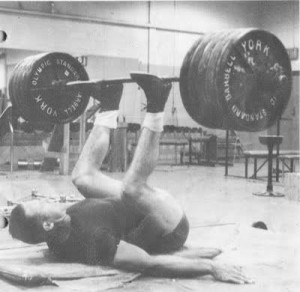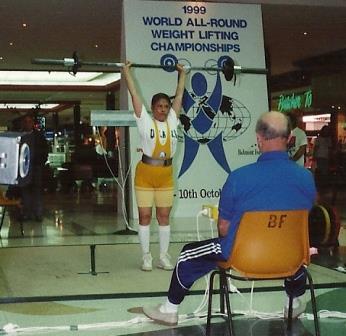Scott Lift
By Al Myers
I have tried at one time every lift in the USAWA Rulebook. Now – I’m not saying I’ve been capable of actually performing every USAWA lift, but I’ve tried them. Many I’ve done USAWA records in at meets or record days thus the reason I have USAWA Records in over 150 different USAWA Official Lifts, more than any other USAWA lifter. Early on a goal of mine was to learn and try all of the USAWA Official Lifts.
One lift I wanted to do at this past years Presidential Cup was the Scott Lift. However, my back at the time was not cooperating thus I had to pick another lift. I have written many blogs on this website covering different lifts, but the Scott Lift is one that has NEVER been written about. Let’s review the rules for it:
D26. Scott Lift
The rules of the Zercher Lift apply with these exceptions. The lifter starts the lift on the knees with the bar placed in the crooks of the elbows. The lifter may roll the bar on the platform in order to gain momentum to start the lift. With the bar fixed at the elbows, the lifter will then stand fully erect while keeping the bar in place. During the rise from the knees, the feet are allowed to move and the bar may be lowered, but the bar or plates must not touch the knees or the platform. Once on the feet, feet placement is optional, but the feet must not move. However, the heels and toes may rise.
All of our USAWA lifts have some sort of history associatied with them, and I’m sure people got to wonder about the history of the Scott Lift. How and why did it get presented? I know very few USAWA members have been around long enough to remember the origins of the Scott Lift. And why was it named the Scott Lift? Well, it has nothing to do with USAWA Hall of Famer Scott Schmidt, past USAWA lifter Charlie Scott, or even the great bodybuilding legend Larry Scott. Strangely, it has nothing to do with anyone who ever lifted a barbell.
I’ll try to tell the story the best I can remember it. In 1996 our past president Howard Prechtel witnessed a young nurse in a care facility pick up a patient from a lying position on the floor and placed the patient onto a bed. She got down on her knees, placed her arms under the patient much like we do when holding a Zercher Lift, proceeded to stand up onto her knees with the patient in her arms, at which point she got one foot under her and then the over and stood up placing the patient on the bed. Howard was inspired by this act of lifting as she lifted from the floor more weight than her own bodyweight to a standing postion! It just so happens that this young female nurse had the last name of Scott.
Howard presented the Scott Lift to the USAWA in 1997 and it was passed as a USAWA Lift. It was also presented at the IAWA meeting that same year but failed, and never was submitted to IAWA again.
The Scott Lift has been rarely contested in the USAWA. Only once has it been in a competition (the 1998 Louis Cyr Challenge at Clark’s Gym), plus done a few times at Record Days. Only 3 lifters have ever exceeded their bodyweight in the Scott Lift – Abe Smith (250 lbs), Chad Ullom (254 lbs), and myself (254 lbs).
I find myself doing this movement at work several times a week picking up anesthetized dogs to carry and place onto the surgery table. It is by far the safest way to pick up a recumbent patient. So that young nurse knew what she was doing! The next time you want to try a different USAWA Lift – give a go at the Scott Lift and see if you can lift more than your own bodyweight so you can match the efforts of that young nurse who never lifted weights.


